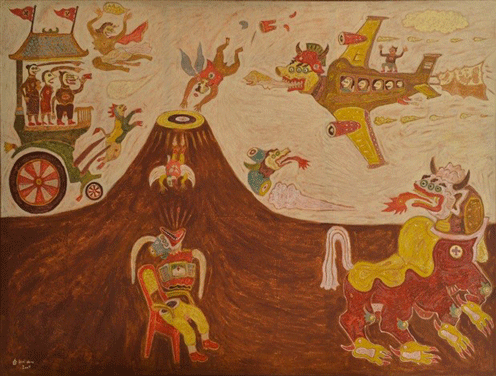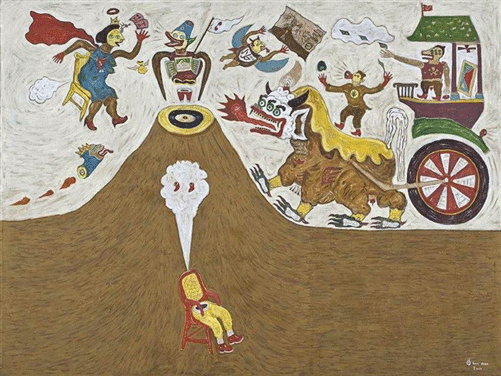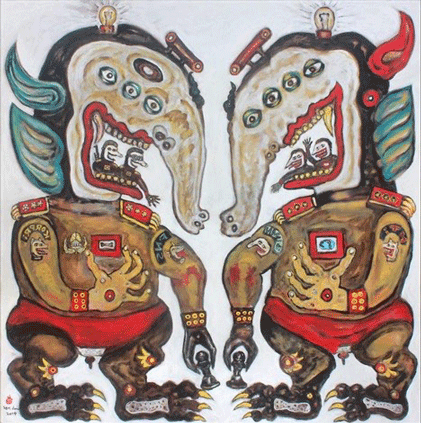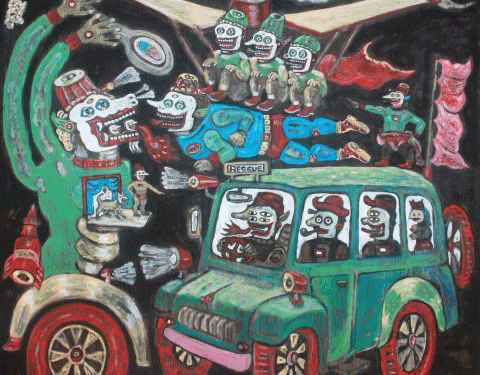Political conflicts— recorded or not recorded— have shattered people’s lives and disproportionately affected those on the forefront. The United Nations has recorded around 70 million people who are fleeing from war, persecution and conflict in 2018. These occurencesis happening stresses the importance of speaking up about these issues in as many mediums as possible.
Born in 1960, Heri Dono is an Indonesian contemporary artist who uses his exhibitions and paintings as an avenue for socio-political comments. At first, Dono’s paintings leave a playful impression with itheirts absurd and deformed characters. The striking bold colours that outline the silhouette juxtaposes the tan and beige undertones. Likewise, the explosive nature of his canvases displays a wild, fun, and freestyle arrangement as if it was taken straight out of a comic panel.
His works align with the United Nations Sustainable Development Goals on Peace, Justice, and Strong Institutions.
On top of that, he keeps the tradition of wayang alive in his portraits. Wayang Kulit is an Indonesian form of shadow puppetry that narrates the stories of kings and knights. It both utilizes visual stylistic elements and musical accompaniment by traditional instruments. Most importantly, it presents a satirical comment about social or political happenings.
“The beauty of shadow puppets is that you have visual art, theatre, handicraft, performance, music – all these different disciplines – working together. ” Dono told Naima Morelli in an interview with Trouble Magazine.


Dono incorporates repetitive imagery such as flying superheroes, volcanoes, a chair, a dragon, and so much more in his work to express different symbolisms. In an interview, he confided some of the caricatures and their meanings;
“I’m using many elements and patterns I’ve used before: the wheel, the fire, the shoes, and yes they all have a meaning: The wheel is the symbol of progress; fire is a symbol of energy; the shoe is a symbol of perhaps military or authority; the hand is a symbol of work, but also a talisman and something to predict the future. I like to put figures in the mouth as a reference to diplomacy, people (say) something with their mouth but not from the heart.”
Looking closely, his thought-provoking paintings encourage the audience to think critically and to reflect onabout these associations. “When I exhibit my work, the Indonesian public understands the irony very quickly. It’s like graffiti or slang language. In this sense visual art communicates quicker than the news on newspapers or television, ” Dono added.
The seemingly innocent caricatures convey a deeper existential meaning. Growing up in a precarious time in Indonesia, he witnessed how authoritarianism engulfed his country and took multiple innocent lives. His artworks provide a glimpse of the social realities not just in Indonesia but the rest of the world.

Coming from its name itself, Playing Chess Pawns depicts two big similar entities playing chess. In literature, chess is often used as a metaphor for the execution of one’s plans. Each piece constitutes a certain move and by strategically placing them, a chess player may outsmart the other.
Further, the painting features pawns thatwhich are often sacrificed in the game. Chess players, in the beginning, use their pawns to gauge the other player’s strategy or are sometimes used as a bait to execute a more complex and well-thought move. In more advanced cases, some players purposefully let their opponents defeat their pawn to advance their other pieces.
The painting can be interpreted in two ways. First, the two entities depict the two opposing forces in Indonesian politics. The pawns can mean any of the soldiers that are deployed by both sides to protect themselves or the collateral damage they wish to sacrifice for them to execute their grand move.
Looking outside the Indonesian vacuum, the two entities can represent the two dominant countries that control the global powers. As both of them push and pull their forces, they tend to deploy their pawns into their game. The pawns here can either be any resources or the neo-colonial countries that are trapped in between the turmoil.

Dono has also critiqued how the pandemic is handled through his work called Three Wise Monkey Find The Vaccine. The monkeys he might be referring to here can be the big pharmaceutical companies who are racing to find the vaccine for COVID-19 or the politicians who are in -charge of the vaccination roll-out.
When asked about his works, Dono said, “Artists have a moral responsibility to add to the conversation, to make people aware of injustices.”
Likewise, sociopolitical issues should not be treated as taboo. An honest critique about it can lead to a fruitful conversation that can incite change. After all, “Art is a medium that people can be united under, from different religions, from different races.”
For more information about Heri Dono’s work or exhibitions, click here.
